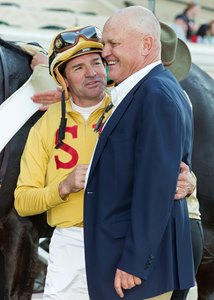Desormeaux Questions Photo Finish System


Based on his experience as a Racing Hall of Fame rider, jockey Kent Desormeaux said he doesn't trust the validity of photo finish systems used to determine placings in close finishes and said the industry should move to an updated system.
Desormeaux expressed his opinion Dec. 12 in Las Vegas, following a presentation on integrity issues by Curtis Linnell, executive vice president of wagering analysis and operations for the Thoroughbred Racing Protective Bureau.
"I don't believe in the validity of the photo finish system, not at all as a matter of fact," Desormeaux said to Linnell. "I know I've been deprived of wins—or the other way around—but I'm pretty certain that we, and you as the Thoroughbred Racing Protective Bureau, need to find a better way to make sure that photo finish was accurate."
Desormeaux said he's been impressed with the technology at Arlington International Racecourse that gives viewers a digital view where he said the winner is easily determined. He believes the current system is susceptible to manipulation.
"I believe they can make the wire where they want," Desormeaux said. "When we're going 40 miles per hour, you can change the finish by a centimeter and show that the horse's nose is on the line or isn't on the line."
While Linnell's expertise is in pool security and integrity, he expressed confidence in the industry's current photo finish system, noting the cameras and their calibration are independently tested.
"That is something controlled, and controlled very closely, expertly; by vendors and regulatory associations," Linnell said. "(The TRPB) has not seen one instance—not one instance—in which there has been evidence a fraudulent photo finish has been perpetrated."
But Desormeaux called the method outdated, basing his opinion on his vast experience of 30,542 starts and 5,813 wins.
"I've seen some races this year, on Breeders' Cup day, that I don't think was the true winner," Desormeaux said. "I want horse racing officials to make me believe that the photo finish was real. I don't believe them. I've been in 30,000 races, I get to the wire and raise my stick then get embarrassed and pulled in and told, 'Well, you didn't win.' Been there, done that."
Dan Fick, a steward in Iowa and vice president of the Racing Officials Accreditation Program, questioned Desormeaux's understanding of the current photo finish system. He noted that the system features a camera with an open camera aperture that accurately captures each horse as it reaches the wire, which is not moved when the digital photo result is examined.
FinishLynx, the photo finish camera in place at many of the major North American and international tracks, says its system is accurate to within 1/1,000th of a second. The Lynx website lists the capabilities of the system.
"Line-scan photo finish cameras usually capture at around 1,000-2,000 frames per second, producing more clear and precise results images. And the EtherLynx PRO line-scan camera captures up to 10,000 frames per second—making it the most accurate sports timing camera in the world," the site said. "The speed and accuracy of line-scan photo-finish cameras simply cannot be matched by any type of RFID (radio frequency identification), photocells, or 2D video cameras found today."
